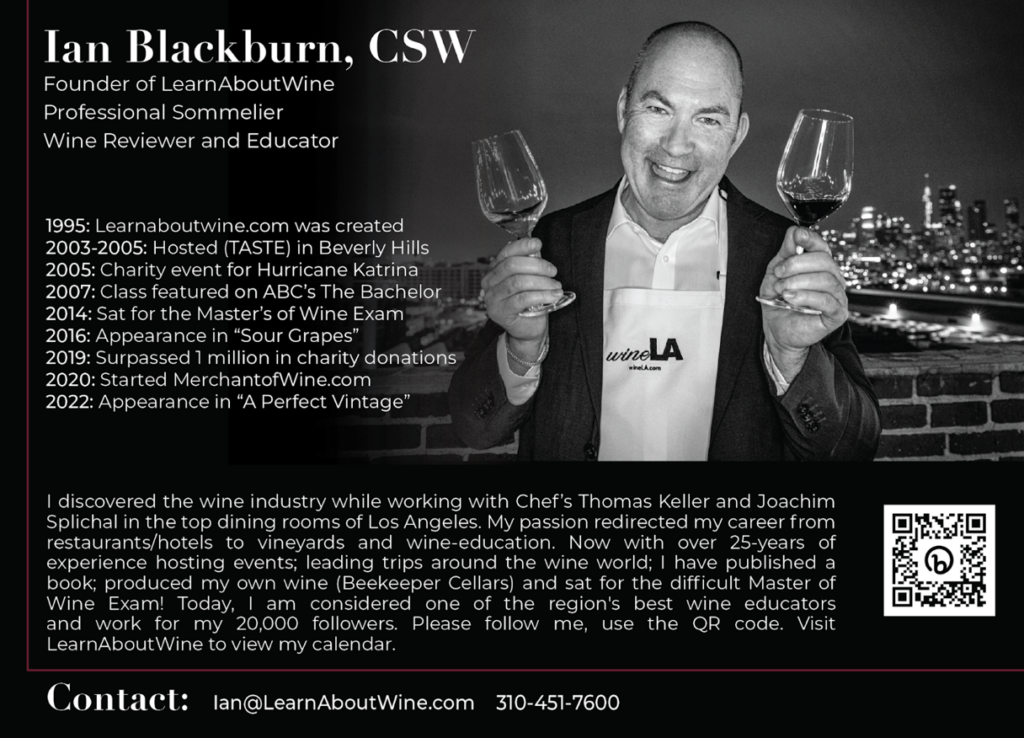LearnAboutWine returns with ‘The 100 Point Dinner’ at JAR Restaurant Thursday, October 5th
LearnAboutWine returns to this fantastic restaurant for another extraordinary effort – a blind tasting of 100 point wines with a 5-course dinner.

The 100 Point Dinner features 21 wines between 100 and 98 points and will be paired with a 5 course dinner.
All wines will be tasted blind, 3 at a time and revealed after guests vote for their favorites!
The question is – which 100 point wine did they prefer? Where is it from and can you guess which wine it is? Take advantage of this rare opportunity to taste “perfect” wines side by side with a delicious dinner prepared by the iconic Jar Chef/Owner Suzanne Tracht.
This event is limited so get tickets here before they sell out!
LearnAboutWine takes a $100 deposit and then post the final payment when the dinner has enough support.
___________________* Example Dinner Menu & Wine List *___________________
This is the menu from LearnAboutWine’s last engagement – the menu changes with seasonal nuances and will be very different.
They can accommodate any dietary restrictions with 72 hour notice.
First Course with a flight of Whites
Roasted Breast of Duck
Potato pancake
Kumquat shallot confit
First Course Whites:
Grosset, Riesling, Polish Hill, South Australia, 2022 | $74 – 98 Points
Hyde de Villaine HdV, Chardonnay, Hyde Vineyard, Carneros, California, 2018 | $80 – 98 Points
Leeuwin Estate, “Art Series” Chardonnay, Margaret River, Western Australia, 2019 | $110 – 98 Points
Second Course – Red Flights (1 and 2)
Rack of Lamb
favas, tendrils
cabernet reduction
Third Course – Red Flights (3 and 4)
Roasted Prime New York Strip
long cooked greens beans
au jus, creamy horseradish
Plus Jar French Fries
Fourth Course Red Flight (5 and 6)
Individual Cheese Plates
Dessert Course:
Mini Chocolate Brownie
Coffee and Tea
RED WINES
(Tasted Blind – Three At A Time):
Bodegas Muga, Torre Muga, Rioja, Spain, 2019 | $150 – 98 Points
Catena Zapata, Argentino Vineyard, Malbec, Mendoza, Argentina, 2020 | $140 – 98 Points
Chateau Figeac, Grand Cru St. Emilion, Bordeaux, France, 2015 | $370 – 100 Points
Château Leoville-Las Cases, ‘Grand Vin de Leoville’, St. Julien, Bordeaux, France, 2009 | $600 – 99 Points
Colgin Cellars, Tychson Hill Cabernet Sauvignon, Napa Valley, California, 2019 | $1,000 – 100 Points
Domaine Jamet, Côte-Rôtie, Rhône, France, 2019 | $245 – 98 Points
Epoch Estate Wines, Authenticity, Paso Robles, California, 2017 | $98 – 98 Points
Jean-Louis Chave, Hermitage Rouge, Rhône Valley, France, 2018 | $400 – 100 Points
Ledge, Bien Nacido Vineyard ‘Block 11’ Syrah, Santa Maria Valley, California, 2020 | $90 – 98 Points
Patria, Cabernet Sauvignon, Oakville Ranch, Napa Valley, 2019 | $110 – 98 Points
Penfolds, Grange Shiraz, Barossa Valley, Australia, 2018 | $900 – 100 Points
Pulido Walker, Cabernet Sauvignon Mt. Veeder Estate, Napa Valley, 2019 | $300 – 99 Points
Scarecrow, Cabernet Sauvignon, Napa Valley, California, 2012 | $1,300 – 98 Points
Sine Qua Non, Eleven Confessions Vineyard Syrah, Central Coast, California, 2017 | $600 – 100 Points
Siro Pacenti, “PS” Brunello di Montalcino Riserva DOCG, Tuscany, Italy, 2015 | $250 – 100 Points
Tenuta San Guido, Sassicaia, Tuscany, Italy, 2019 | $325 – 100 Points
Viña Cobos, Chanares Estate Cabernet Franc, Uco Valley, Argentina, 2019 $125 – 98 Points
Dessert Course:
Taylor Fladgate, Very Old Single Harvest Port, Oporto, Portugal, 1968 | $300 – 98 Points





